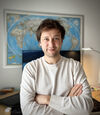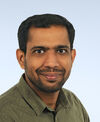Institute for Systems medicine with focus on organ interaction
Prof. Dr. Lars Kuepfer
The Kuepfer group combines physiologically-based pharmacokinetic (PBPK) modelling at the whole-body level with systems biology effect models at the cellular and tissue scale. The resulting multiscale models are used for the analyses of organ systems such as the gut-liver-axis as well as in applications of quantitative systems pharmacology and toxicology.
Prof. Dr. Lars Kuepfer

Lars Kuepfer studied chemical engineering at the TH Karlsruhe, RWTH Aachen and Carnegie Mellon University, Pittsburgh, and received his Ph.D. degree from ETH Zurich. In his thesis, Lars Kuepfer analyzed metabolic and regulatory principles in yeast based on computational models. In 2005, he joined Bayer AG, where he worked on pharmacokinetic and pharmacodynamic modeling of novel drug candidates to support decision making along the pharma development process. In addition, Lars Kuepfer also started as a group leader at the Institute of Applied Microbiology of the RWTH Aachen in 2011. In 2021, he became professor for systems medicine with focus on organ interactions. Lars Kuepfer’s main research interests are in the areas of physiologically-based pharmacokinetic (PBPK) modelling, systems biology as well as pharmacology and toxicology.
Researchgate
ORCID iD
Dr. Zita Soons

Zita Soons is a postdoctoral researcher in systems biology of human and microbial metabolism. She develops and applies metabolic models aimed at mechanistic understanding of bio(medical) processes. To this end, she collaborates with experimental and medical groups. At RWTH, she integrates metabolic pathway analysis with physiologically-based pharmacokinetic (PBPK) modelling applied to the microbiome and the kidney. Zita studied biotechnology at Wageningen University. Her dissertation represents computational work at the Systems and Control Group and lab experiments at the Netherlands Vaccine Institute. She obtained a grant for a postdoc on metabolic modelling at the University of Minho (Portugal) in 2009–2012, which involved a six month visit at EMBL Heidelberg. Next, she pursued a postdoc at the DKFZ/Heidelberg University. She taught her first courses at the Department of Knowledge Engineering of Maastricht University and worked as assistant professor at the Department of Surgery of MUMC+ (The Netherlands) until 2020.
Reasearchgate
ORCIDiD
Ömer Bay

Ömer Faruk Bay holds a degree in Molecular Biology and Genetics from Atatürk University, Türkiye, and earned his master's in Systems Biology and Bioinformatics, followed by a Ph.D. in Bioinformatics from the University of Manchester, United Kingdom. His doctoral research focuses on the metabolism of Trichuris muris, where he pioneered the development of the first genome-scale metabolic model for this parasitic whipworm. This model allowed him to develop novel therapeutic targets for more effective treatment strategies. Currently affiliated with Lars Kuepfer’s group, his primary focus revolves around the reconstruction of genome-scale metabolic models for the members of the synthetic mouse intestinal bacterial community, known as Oligo Mouse Microbiota 19 (OMM19). By delving into their metabolic capabilities and interactions, he aims to enhance our understanding of their collective phenotype and resilience to perturbations.
René Geci

René is a PhD student who obtained his bachelor’s degree in Biosciences, and also his master’s in Systems Biology, from the University of Heidelberg. At the start of his studies, he did genetic and microbiological work in the wet lab, but then got fascinated by the world of modelling and quickly switched agar plates and pipettes for the computer. After some short excursions into population genetics and the spatial modelling of calcium waves, he is enthusiastic to now dive deeper into toxicological and pharmacological modelling. Together with esqLABS GmbH, he will be working on the ONTOX project and a CRACK IT challenge to advance methods for the toxicological assessment of chemicals.
LinkedIn
Ravi Jairam

Ravi Jairam obtained his bachelor's degree in pharmacy and master's degree in pharmacology from Rajiv Gandhi University of Health Sciences Karnataka, India. He has overall nine years of experience in the pharmaceutical industry as a Pharmacokinetics Scientist in the department of Drug Metabolism and Pharmacokinetics (DMPK). He has joined the University Hospital RWTH Aachen for a Ph.D. project on ocular pharmacokinetics and physiological-based pharmacokinetic (PBPK) modeling and will be working in collaboration with Boehringer Ingelheim Pharma GmbH to improve ocular disposition for protein therapeutics.
Reasearchgate
Ahenk Zeynep Sayin

Ahenk Zeynep Sayin obtained her bachelor’s degree in chemical engineering from Bogazici University, Turkey and master’s degree in chemical and biological engineering from Koc University, Turkey. In her master‘s thesis, she studied drug repurposing in Ras pathway based on structural similarities of protein-protein interfaces. She has joined to University Hospital RWTH Aachen in November 2023 for a PhD project on physiologically-based pharmacokinetic (PBPK) modelling of drug-induced cholestasis in collaboration with Bayer AG and PortaCellTec. The aim of this project is to evaluate the potential risk of cholestasis of different compounds based on their effects on liver transporters and bile acid metabolism.
Orcid iD
2024
- Pollmanns, M.R., Kister, B., Abu Jhaisha, S., Adams, J.K., Kabak, E., Brozat, J.F., Schneider, C.V., Hohlstein, P., Bruns, T., Küpfer, L., Trautwein, C., Koch, A., Wirtz, T. H. The Aachen, ACLF ICU score predicts ICU mortality in critically ill patients with acute-on-chronic liver failure.Sci Rep 2024;14:30497.
- Meiners, F., Hinz, B., Boeckmann, L., Secci, R., Sueto, S., Kuepfer, L., Fuellen, G., Barrantes, I. Computational identification of natural senotherapeutic compounds that mimic dasatinib based on gene expression data. Sci Rep 2024;14:6286.
- Jairam, R.K., Franz, M., Hanke, N., Kuepfer, L. Physiologically based pharmacokinetic models for systemic disposition of protein therapeutics in rabbits. Front Pharmacol 2024;15:1427325.
- Geci R., Gadaleta D., de Lomana M.G., Ortega-Vallbona R., Colombo E., Serrano-Candelas E., Paini A., Kuepfer, L., Schaller, S. et al. Systematic evaluation of high-throughput PBK modelling strategies for the prediction of intravenous and oral pharmacokinetics in humans. Arch Toxicol 2024;98:2659-2676.
- Franz M., Jairam R.K., Kuepfer L., Hanke N. PBPK-based translation from preclinical species to humans for the full-size IgG therapeutic efalizumab. Front Pharmacol 2024;15:1418870.
2023
- Fendt, R., A. Ghallab, M. Myllys, U. Hofmann, R. Hassan, Z. Hobloss, D. Gonzalez, L. Brackhagen, R. Marchan, K. Edlund, A.L. Seddek, N. Abdelmageed, L.M. Blank, J.F. Schlender, C.H. Holland, J.G. Hengstler, and L. Kuepfer. 2023. Increased sinusoidal export of drug glucuronides is a compensative mechanism in liver cirrhosis of mice. Front Pharmacol 14:1279357.
- Kister, B., A. Viehof, U. Rolle-Kampczyk, A. Schwentker, N.S. Treichel, S.A.V. Jennings, T.H. Wirtz, L.M. Blank, M.W. Hornef, M. von Bergen, T. Clavel, and L. Kuepfer. 2023. A physiologically based model of bile acid metabolism in mice. iScience 26:107922.
- Kuepfer, L., G. Fuellen, and T. Stahnke. 2023. Quantitative systems pharmacology of the eye: Tools and data for ocular QSP. CPT Pharmacometrics Syst Pharmacol
- Soppert, J., E.F. Brandt, N.M. Heussen, E. Barzakova, L.M. Blank, L. Kuepfer, M.W. Hornef, J. Trebicka, J. Jankowski, M.L. Berres, and H. Noels. 2023. Blood Endotoxin Levels as Biomarker of Nonalcoholic Fatty Liver Disease: A Systematic Review and Meta-analysis. Clin Gastroenterol Hepatol 21:2746-2758.
2022
- Mpabanzi, L., J. Wainwright, B. Boonen, H. van Eijk, D. Dhar, E. Karssemeijer, C.H.C. Dejong, R. Jalan, J.M. Schwartz, S.W.M. Olde Damink, and Z. Soons. 2022. Fluxomics reveals cellular and molecular basis of increased renal ammoniagenesis. NPJ Syst Biol Appl 8:49.
- Geci, R., K. Willis, and A. Burt. 2022. Gene drive designs for efficient and localisable population suppression using Y-linked editors. PLoS Genet 18:e1010550.
- Soppert, J., E.F. Brandt, N.M. Heussen, E. Barzakova, L.M. Blank, L. Kuepfer, M.W. Hornef, J. Trebicka, J. Jankowski, M.L. Berres, and H. Noels. 2022. Blood endotoxin levels as biomarker of non-alcoholic fatty liver disease: a systematic review and meta-analysis. Clin Gastroenterol Hepatol
- Schneider, A.R.P., C.V. Schneider, K.M. Schneider, V. Baier, S. Schaper, C. Diedrich, K. Coboeken, H. Mayer, W. Gu, J. Trebicka, L.M. Blank, R. Burghaus, J. Lippert, D.J. Rader, C.A. Thaiss, J.F. Schlender, C. Trautwein, and L. Kuepfer. 2022. Early prediction of decompensation (EPOD) score: Non-invasive determination of cirrhosis decompensation risk. Liver Int 42:640-650.
- Collin, C.B., T. Gebhardt, M. Golebiewski, T. Karaderi, M. Hillemanns, F.M. Khan, A. Salehzadeh-Yazdi, M. Kirschner, S. Krobitsch, EU-STANDS4PM consortium, and L. Kuepfer. 2022. Computational Models for Clinical Applications in Personalized Medicine-Guidelines and Recommendations for Data Integration and Model Validation. J Pers Med 12:
- Verheijen, M., U. Sarkans, W. Wolski, D. Jennen, F. Caiment, J. Kleinjans, and HeCaToS Consortium. 2022. Multi-omics HeCaToS dataset of repeated dose toxicity for cardiotoxic & hepatotoxic compounds. Sci Data 9:699.
2021
- Baier, V., O. Clayton, R. Nudischer, H. Cordes, A.R.P. Schneider, C. Thiel, T. Wittenberger, W. Moritz, L.M. Blank, U.P. Neumann, C. Trautwein, J. Kelm, Y. Schrooders, F. Caiment, H. Gmuender, A. Roth, J.V. Castell, J. Kleinjans, and L. Kuepfer. 2021. A Model-Based Workflow to Benchmark the Clinical Cholestasis Risk of Drugs. Clin Pharmacol Ther 110:1293-1301.
- Fendt, R., U. Hofmann, A.R.P. Schneider, E. Schaeffeler, R. Burghaus, A. Yilmaz, L.M. Blank, R. Kerb, J. Lippert, J.F. Schlender, M. Schwab, and L. Kuepfer. 2021. Data-driven personalization of a physiologically based pharmacokinetic model for caffeine: A systematic assessment. CPT Pharmacometrics Syst Pharmacol 10:782-793.
- Ghallab, A., R. Hassan, M. Myllys, W. Albrecht, A. Friebel, S. Hoehme, U. Hofmann, A.L. Seddek, A. Braeuning, L. Kuepfer, B. Cramer, H.U. Humpf, P. Boor, G.H. Degen, and J.G. Hengstler. 2021. Subcellular spatio-temporal intravital kinetics of aflatoxin B(1) and ochratoxin A in liver and kidney. Arch Toxicol 95:2163-2177.
- Marx, G., J. Bickenbach, S.J. Fritsch, J.B. Kunze, O. Maassen, S. Deffge, J. Kistermann, S. Haferkamp, I. Lutz, N.K. Voellm, V. Lowitsch, R. Polzin, K. Sharafutdinov, H. Mayer, L. Kuepfer, R. Burghaus, W. Schmitt, J. Lippert, M. Riedel, C. Barakat, A. Stollenwerk, S. Fonck, C. Putensen, S. Zenker, F. Erdfelder, D. Grigutsch, R. Kram, S. Beyer, K. Kampe, J.E. Gewehr, F. Salman, P. Juers, S. Kluge, D. Tiller, E. Wisotzki, S. Gross, L. Homeister, F. Bloos, A. Scherag, D. Ammon, S. Mueller, J. Palm, P. Simon, N. Jahn, M. Loeffler, T. Wendt, T. Schuerholz, P. Groeber, and A. Schuppert. 2021. Algorithmic surveillance of ICU patients with acute respiratory distress syndrome (ASIC): protocol for a multicentre stepped-wedge cluster randomised quality improvement strategy. BMJ Open 11:e045589.
- Cao, J., B. Balluff, M. Arts, L.J. Dubois, L.J.C. van Loon, T.M. Hackeng, H.M.H. van Eijk, G. Eijkel, L.R. Heij, Z. Soons, S.W.M. Olde Damink, and R.M.A. Heeren. 2021. Mass spectrometry imaging of L-[ring-(13)C(6)]-labeled phenylalanine and tyrosine kinetics in non-small cell lung carcinoma. Cancer Metab 9:26.
- Ubachs, J., J. Ziemons, Z. Soons, R. Aarnoutse, D.P.J. van Dijk, J. Penders, A. van Helvoort, M.L. Smidt, R. Kruitwagen, L. Baade-Corpelijn, S.W.M. Olde Damink, and S.S. Rensen. 2021. Gut microbiota and short-chain fatty acid alterations in cachectic cancer patients. J Cachexia Sarcopenia Muscle 12:2007-2021.
2020
- Schneckener, S., T.G. Preuss, L. Kuepfer, and J. Witt. 2020. A workflow to build PBTK models for novel species. Arch Toxicol 94:3847-3860.
- Selevsek, N., F. Caiment, R. Nudischer, H. Gmuender, I. Agarkova, F.L. Atkinson, I. Bachmann, V. Baier, G. Barel, C. Bauer, S. Boerno, N. Bosc, O. Clayton, H. Cordes, S. Deeb, S. Gotta, P. Guye, A. Hersey, F.M.I. Hunter, L. Kunz, A. Lewalle, M. Lienhard, J. Merken, J. Minguet, B. Oliveira, C. Pluess, U. Sarkans, Y. Schrooders, J. Schuchhardt, I. Smit, C. Thiel, B. Timmermann, M. Verheijen, T. Wittenberger, W. Wolski, A. Zerck, S. Heymans, L. Kuepfer, A. Roth, R. Schlapbach, S. Niederer, R. Herwig, and J. Kleinjans. 2020. Network integration and modelling of dynamic drug responses at multi-omics levels. Commun Biol 3:573.
2019
- Baier, V., H. Cordes, C. Thiel, J.V. Castell, U.P. Neumann, L.M. Blank, and L. Kuepfer. 2019. A Physiology-Based Model of Human Bile Acid Metabolism for Predicting Bile Acid Tissue Levels After Drug Administration in Healthy Subjects and BRIC Type 2 Patients. Front Physiol 10:1192
- Albrecht, W., F. Kappenberg, T. Brecklinghaus, R. Stoeber, R. Marchan, M. Zhang, K. Ebbert, H. Kirschner, M. Grinberg, M. Leist, W. Moritz, C. Cadenas, A. Ghallab, J. Reinders, N. Vartak, C. van Thriel, K. Golka, L. Tolosa, J.V. Castell, G. Damm, D. Seehofer, A. Lampen, A. Braeuning, T. Buhrke, A.C. Behr, A. Oberemm, X. Gu, N. Kittana, B. van de Water, R. Kreiling, S. Fayyaz, L. van Aerts, B. Smedsrod, H. Ellinger-Ziegelbauer, T. Steger-Hartmann, U. Gundert-Remy, A. Zeigerer, A. Ullrich, D. Runge, S.M.L. Lee, T.S. Schiergens, L. Kuepfer, A. Aguayo-Orozco, A. Sachinidis, K. Edlund, I. Gardner, J. Rahnenfuhrer, and J.G. Hengstler. 2019. Prediction of human drug-induced liver injury (DILI) in relation to oral doses and blood concentrations. Arch Toxicol 93:1609-1637.
- Ghallab, A., U. Hofmann, S. Sezgin, N. Vartak, R. Hassan, A. Zaza, P. Godoy, K.M. Schneider, G. Guenther, Y.A. Ahmed, A.A. Abbas, V. Keitel, L. Kuepfer, S. Dooley, F. Lammert, C. Trautwein, M. Spiteller, D. Drasdo, A.F. Hofmann, P.L.M. Jansen, J.G. Hengstler, and R. Reif. 2019. Bile Microinfarcts in Cholestasis Are Initiated by Rupture of the Apical Hepatocyte Membrane and Cause Shunting of Bile to Sinusoidal Blood. Hepatology 69:666-683.
- Kalra, P., J. Brandl, T. Gaub, C. Niederalt, J. Lippert, S. Sahle, L. Kupfer, and U. Kummer. 2019. Quantitative systems pharmacology of interferon alpha administration: A multi-scale approach. PLoS One 14:e0209587.
2018
- Apweiler, R., T. Beissbarth, M.R. Berthold, N. Bluthgen, Y. Burmeister, O. Dammann, A. Deutsch, F. Feuerhake, A. Franke, J. Hasenauer, S. Hoffmann, T. Hofer, P.L. Jansen, L. Kaderali, U. Klingmuller, I. Koch, O. Kohlbacher, L. Kuepfer, F. Lammert, D. Maier, N. Pfeifer, N. Radde, M. Rehm, I. Roeder, J. Saez-Rodriguez, U. Sax, B. Schmeck, A. Schuppert, B. Seilheimer, F.J. Theis, J. Vera, and O. Wolkenhauer. 2018. Whither systems medicine? Exp Mol Med 50:e453.
- Cordes, H., C. Thiel, V. Baier, L.M. Blank, and L. Kuepfer. 2018. Integration of genome-scale metabolic networks into whole-body PBPK models shows phenotype-specific cases of drug-induced metabolic perturbation. NPJ Syst Biol Appl 4:10.
- Kuepfer, L., O. Clayton, C. Thiel, H. Cordes, R. Nudischer, L.M. Blank, V. Baier, S. Heymans, F. Caiment, A. Roth, D.A. Fluri, J.M. Kelm, J. Castell, N. Selevsek, R. Schlapbach, H. Keun, J. Hynes, U. Sarkans, H. Gmuender, R. Herwig, S. Niederer, J. Schuchhardt, M. Segall, and J. Kleinjans. 2018. A model-based assay design to reproduce in vivo patterns of acute drug-induced toxicity. Arch Toxicol 92:553-555.
- Niederalt, C., L. Kuepfer, J. Solodenko, T. Eissing, H.U. Siegmund, M. Block, S. Willmann, and J. Lippert. 2018. A generic whole body physiologically based pharmacokinetic model for therapeutic proteins in PK-Sim. J Pharmacokinet Pharmacodyn 45:235-257.
- Thiel, C., I. Smit, V. Baier, H. Cordes, B. Fabry, L.M. Blank, and L. Kuepfer. 2018. Using quantitative systems pharmacology to evaluate the drug efficacy of COX-2 and 5-LOX inhibitors in therapeutic situations. NPJ Syst Biol Appl 4:28.
- Verheijen, M., Y. Schrooders, H. Gmuender, R. Nudischer, O. Clayton, J. Hynes, S. Niederer, H. Cordes, L. Kuepfer, J. Kleinjans, and F. Caiment. 2018. Bringing in vitro analysis closer to in vivo: Studying doxorubicin toxicity and associated mechanisms in 3D human microtissues with PBPK-based dose modelling. Toxicol Lett 294:184-192.
2017
- Krauss, M., U. Hofmann, C. Schafmayer, S. Igel, J. Schlender, C. Mueller, M. Brosch, W. von Schoenfels, W. Erhart, A. Schuppert, M. Block, E. Schaeffeler, G. Boehmer, L. Goerlitz, J. Hoecker, J. Lippert, R. Kerb, J. Hampe, L. Kuepfer, and M. Schwab. 2017. Translational learning from clinical studies predicts drug pharmacokinetics across patient populations. NPJ Syst Biol Appl 3:11.
- Reif, R., A. Ghallab, L. Beattie, G. Gunther, L. Kuepfer, P.M. Kaye, and J.G. Hengstler. 2017. In vivo imaging of systemic transport and elimination of xenobiotics and endogenous molecules in mice. Arch Toxicol 91:1335-1352.
- Schenk, A., A. Ghallab, U. Hofmann, R. Hassan, M. Schwarz, A. Schuppert, L.O. Schwen, A. Braeuning, D. Teutonico, J.G. Hengstler, and L. Kuepfer. 2017. Physiologically-based modelling in mice suggests an aggravated loss of clearance capacity after toxic liver damage. Sci Rep 7:6224.
- Sezgin, S., R. Hassan, S. Zuhlke, L. Kuepfer, J.G. Hengstler, M. Spiteller, and A. Ghallab. 2018. Spatio-temporal visualization of the distribution of acetaminophen as well as its metabolites and adducts in mouse livers by MALDI MSI. Arch Toxicol 92:2963-2977.
- Thiel, C., H. Cordes, V. Baier, L.M. Blank, and L. Kuepfer. 2017a. Multiscale modeling reveals inhibitory and stimulatory effects of caffeine on acetaminophen-induced toxicity in humans. CPT Pharmacometrics Syst Pharmacol 6:136-146.
- Thiel, C., H. Cordes, I. Conde, J.V. Castell, L.M. Blank, and L. Kuepfer. 2017b. Model-based contextualization of in vitro toxicity data quantitatively predicts in vivo drug response in patients. Arch Toxicol 91:865-883.
- Thiel, C., H. Cordes, L. Fabbri, H.E. Aschmann, V. Baier, I. Smit, F. Atkinson, L.M. Blank, and L. Kuepfer. 2017c. A Comparative Analysis of Drug-Induced Hepatotoxicity in Clinically Relevant Situations. PLoS Comput Biol 13:e1005280.
2016
- Cordes, H., C. Thiel, H.E. Aschmann, V. Baier, L.M. Blank, and L. Kuepfer. 2016. A Physiologically Based Pharmacokinetic Model of Isoniazid and Its Application in Individualizing Tuberculosis Chemotherapy. Antimicrob Agents Chemother 60:6134-6145.
- Ghallab, A., G. Celliere, S.G. Henkel, D. Driesch, S. Hoehme, U. Hofmann, S. Zellmer, P. Godoy, A. Sachinidis, M. Blaszkewicz, R. Reif, R. Marchan, L. Kuepfer, D. Haussinger, D. Drasdo, R. Gebhardt, and J.G. Hengstler. 2016. Model-guided identification of a therapeutic strategy to reduce hyperammonemia in liver diseases. J Hepatol 64:860-871.
- Kuepfer, L., C. Niederalt, T. Wendl, J.F. Schlender, S. Willmann, J. Lippert, M. Block, T. Eissing, and D. Teutonico. 2016. Applied Concepts in PBPK Modeling: How to Build a PBPK/PD Model. CPT Pharmacometrics Syst Pharmacol 5:516-531.
- Kuepfer, L., and A. Schuppert. 2016. Systems Medicine in Pharmaceutical Research and Development. Methods Mol Biol 1386:87-104.
- Lippert, J., R. Burghaus, L. Kuepfer, B. Ploeger, S. Schaller, W. Schmitt, and S. Willmann. 2016. Modeling and Simulation of In Vivo Drug Effects. Handb Exp Pharmacol 232:313-329.
- Schwen, L.O., A. Homeyer, M. Schwier, U. Dahmen, O. Dirsch, A. Schenk, L. Kuepfer, T. Preusser, and A. Schenk. 2016. Zonated quantification of steatosis in an entire mouse liver. Comput Biol Med 73:108-118.
- Wadehn, F., S. Schaller, T. Eissing, M. Krauss, and L. Kupfer. 2016. A multiscale, model-based analysis of the multi-tissue interplay underlying blood glucose regulation in type I diabetes. Annu Int Conf IEEE Eng Med Biol Soc 2016:1417-1421.
2015
- Krauss, M., K. Tappe, A. Schuppert, L. Kuepfer, and L. Goerlitz. 2015. Bayesian Population Physiologically-Based Pharmacokinetic (PBPK) Approach for a Physiologically Realistic Characterization of Interindividual Variability in Clinically Relevant Populations. PLoS One 10:e0139423.
- Schwen, L.O., A. Schenk, C. Kreutz, J. Timmer, M.M. Bartolome Rodriguez, L. Kuepfer, and T. Preusser. 2015. Representative Sinusoids for Hepatic Four-Scale Pharmacokinetics Simulations. PLoS One 10:e0133653.
- Thiel, C., S. Schneckener, M. Krauss, A. Ghallab, U. Hofmann, T. Kanacher, S. Zellmer, R. Gebhardt, J.G. Hengstler, and L. Kuepfer. 2015. A systematic evaluation of the use of physiologically based pharmacokinetic modeling for cross-species extrapolation. J Pharm Sci 104:191-206.
2014
- Drasdo, D., J. Bode, U. Dahmen, O. Dirsch, S. Dooley, R. Gebhardt, A. Ghallab, P. Godoy, D. Haussinger, S. Hammad, S. Hoehme, H.G. Holzhutter, U. Klingmuller, L. Kuepfer, J. Timmer, M. Zerial, and J.G. Hengstler. 2014. The virtual liver: state of the art and future perspectives. Arch Toxicol 88:2071-2075.
- Schwen, L.O., M. Krauss, C. Niederalt, F. Gremse, F. Kiessling, A. Schenk, T. Preusser, and L. Kuepfer. 2014. Spatio-temporal simulation of first pass drug perfusion in the liver. PLoS Comput Biol 10:e1003499.
- Kuepfer, L. 2014. Stoichiometric modelling of microbial metabolism. Methods Mol Biol 1191:3-18.
- Kuepfer, L., R. Kerb, and A.M. Henney. 2014. Clinical translation in the virtual liver network. CPT Pharmacometrics Syst Pharmacol 3:e127.
- Wolkenhauer, O., C. Auffray, O. Brass, J. Clairambault, A. Deutsch, D. Drasdo, F. Gervasio, L. Preziosi, P. Maini, A. Marciniak-Czochra, C. Kossow, L. Kuepfer, K. Rateitschak, I. Ramis-Conde, B. Ribba, A. Schuppert, R. Smallwood, G. Stamatakos, F. Winter, and H. Byrne. 2014. Enabling multiscale modeling in systems medicine. Genome Med 6:21.
2013
- Krauss, M., R. Burghaus, J. Lippert, M. Niemi, P. Neuvonen, A. Schuppert, S. Willmann, L. Kuepfer, and L. Gorlitz. 2013. Using Bayesian-PBPK modeling for assessment of inter-individual variability and subgroup stratification. In Silico Pharmacol 1:6.
2012
- Krauss, M., S. Schaller, S. Borchers, R. Findeisen, J. Lippert, and L. Kuepfer. 2012. Integrating cellular metabolism into a multiscale whole-body model. PLoS Comput Biol 8:e1002750.
- Lippert, J., M. Brosch, O. von Kampen, M. Meyer, H.U. Siegmund, C. Schafmayer, T. Becker, B. Laffert, L. Gorlitz, S. Schreiber, P.J. Neuvonen, M. Niemi, J. Hampe, and L. Kuepfer. 2012. A mechanistic, model-based approach to safety assessment in clinical development. CPT Pharmacometrics Syst Pharmacol 1:e13.
- Meyer, M., S. Schneckener, B. Ludewig, L. Kuepfer, and J. Lippert. 2012. Using expression data for quantification of active processes in physiologically based pharmacokinetic modeling. Drug Metab Dispos 40:892-901.
- Niederalt, C., T. Wendl, L. Kuepfer, K. Claassen, R. Loosen, S. Willmann, J. Lippert, M. Schultze-Mosgau, J. Winkler, R. Burghaus, M. Brautigam, H. Pietsch, and P. Lengsfeld. 2012. Development of a physiologically based computational kidney model to describe the renal excretion of hydrophilic agents in rats. Front Physiol 3:494.
2011
- Burghaus, R., K. Coboeken, T. Gaub, L. Kuepfer, A. Sensse, H.U. Siegmund, W. Weiss, W. Mueck, and J. Lippert. 2011. Evaluation of the efficacy and safety of rivaroxaban using a computer model for blood coagulation. PLoS One 6:e17626.
- Eissing, T., L. Kuepfer, C. Becker, M. Block, K. Coboeken, T. Gaub, L. Goerlitz, J. Jaeger, R. Loosen, B. Ludewig, M. Meyer, C. Niederalt, M. Sevestre, H.U. Siegmund, J. Solodenko, K. Thelen, U. Telle, W. Weiss, T. Wendl, S. Willmann, and J. Lippert. 2011. A computational systems biology software platform for multiscale modeling and simulation: integrating whole-body physiology, disease biology, and molecular reaction networks. Front Physiol 2:4.
2010
- Blank, L.M., and L. Kuepfer. 2010. Metabolic flux distributions: genetic information, computational predictions, and experimental validation. Appl Microbiol Biotechnol 86:1243-1255.
- Kuepfer, L. 2010. Towards whole-body systems physiology. Mol Syst Biol 6:409.
2007
- Kuepfer, L., M. Peter, U. Sauer, and J. Stelling. 2007a. Ensemble modeling for analysis of cell signaling dynamics. Nat Biotechnol 25:1001-1006.
- Kuepfer, L., U. Sauer, and P.A. Parrilo. 2007b. Efficient classification of complete parameter regions based on semidefinite programming. BMC Bioinformatics 8:12.
- Schuetz, R., L. Kuepfer, and U. Sauer. 2007. Systematic evaluation of objective functions for predicting intracellular fluxes in Escherichia coli. Mol Syst Biol 3:119.
2005
- Blank, L.M., L. Kuepfer, and U. Sauer. 2005. Large-scale 13C-flux analysis reveals mechanistic principles of metabolic network robustness to null mutations in yeast. Genome Biol 6:R49.
- Kuepfer, L., U. Sauer, and L.M. Blank. 2005. Metabolic functions of duplicate genes in Saccharomyces cerevisiae. Genome Res 15:1421-1430.
We are constantly looking for interested and motivated students and PhDs.
Master Thesis - Computational analysis of pancreatic cancer treatment with gemcitabine
For more information, please click here.
Physiologically based simulation of tumor drug disposition
For more information, please click here.
Bachelor/Master Thesis Reconstruction of metabolic networks for gut microbiota of OMM12 strains
For more information, please click here.
EPOD score calculator
Calculate the Early prediction of decompensation (EPOD) score to evaluate the risk of decompensation.
Disclaimer: All interpretations provided by the EPOD score calculator are for research use only, not for diagnostic or clinical purposes. No clinical decision should be based solely on the results of this calculator.



